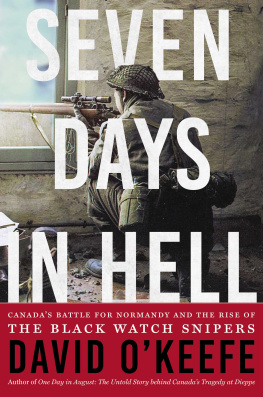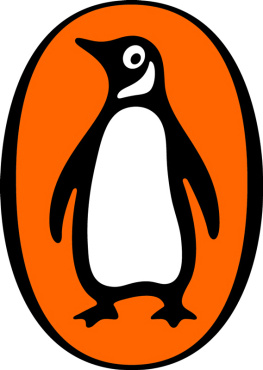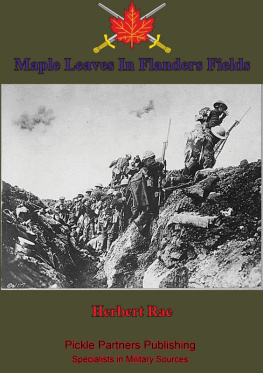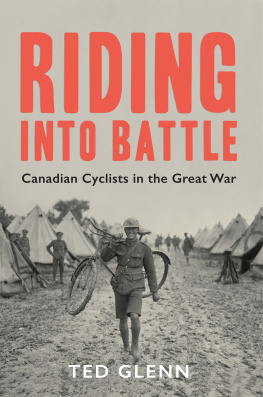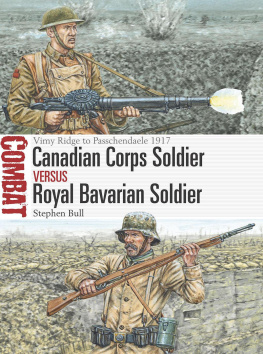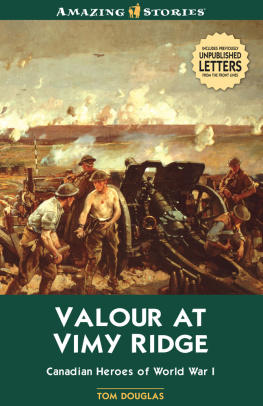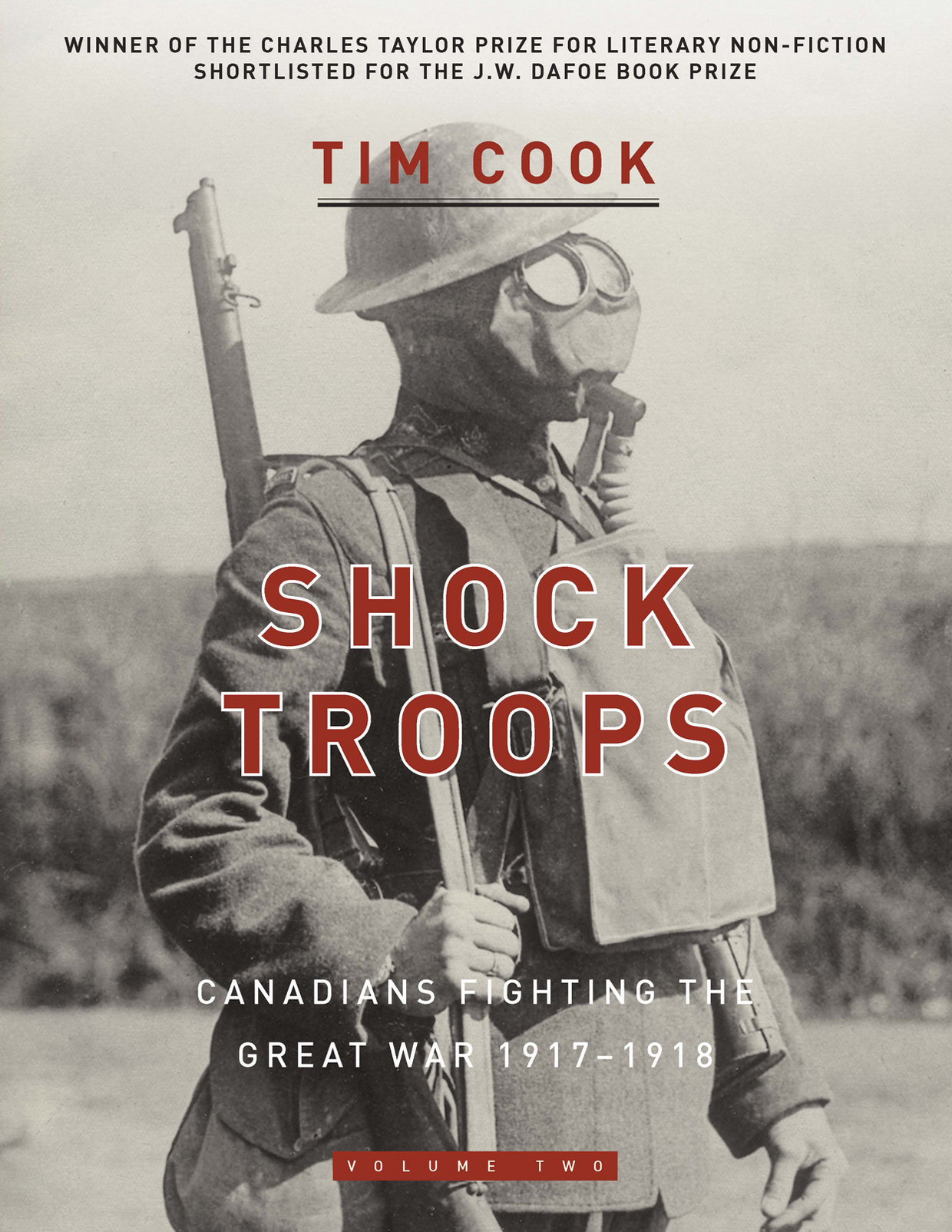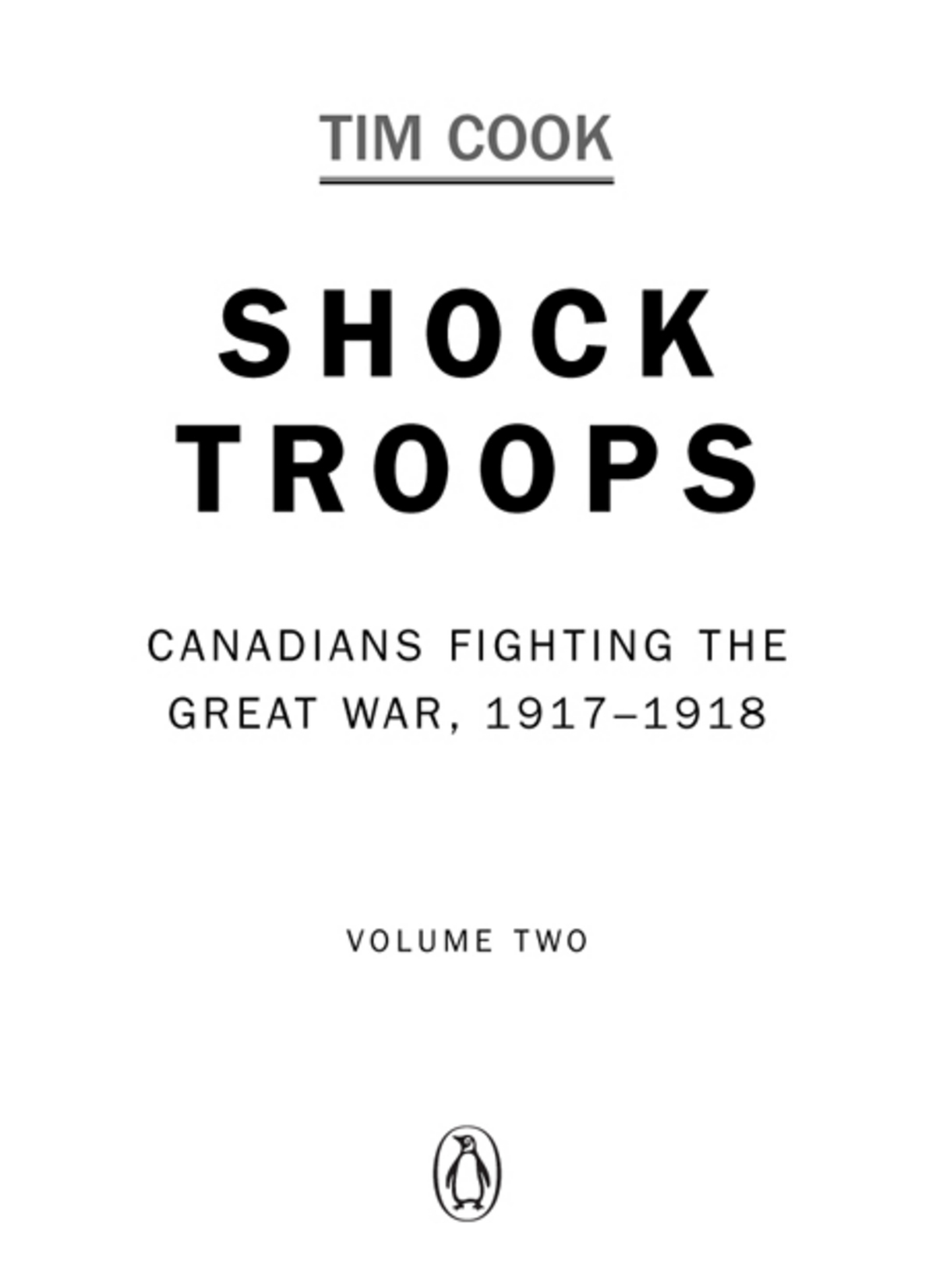Contents
Praise for Tim Cook
Cook has written what will surely be the definitive history of the Canadian Army in the First World War.Edmonton Journal
Shock Troops never lets us forget that when the barrage lifted and the whistles blew, everything rested on the shoulders of the men about to clamber over the top.The Globe and Mail
If you want to know more about the Canadian experience in the Great War, these books are a fine resourceexhaustively researched and yet vividly accessible.The Star Phoenix (Saskatoon)
Tim Cook knows more about WWI than you ever will. National Post
Compelling narrative[Cooks] easy-going style, interesting personal stories and attention to detail engage the reader. Ottawa Sun
Gripping history. The Gazette (Montreal)
Military scholar John Keegan described how military history ought to be writtenrigorously but vigorously, with emotional passion but intellectual dispassion[and] Shock Troops and its predecessor, At the Sharp End, reach this lofty standard. They will remain essential reading for historians and anyone interested in the Canadian Expeditionary Force for years to come. Guelph Mercury
Praise for At The Sharp End Canadians Fighting the Great War, 19141916, Volume One
Winner of the J.W. Dafoe Book Prize and the Ottawa Book Award
Nominated for the British Columbia Award for Canadian Non-Fiction
An authoritative and brightly written narrative. The Gazette (Montreal)
Cook has produced an impeccably researched and immensely readable account of the Great War. The mark of a good historian is finding new ways to tell a tale we thought we knew, and Cook has that quality in spades. The Globe and Mail
Exhaustively researched and written with great narrative momentum, At the Sharp End creates an unforgettable canvas of Canadas men at war. Hill Times (Ottawa)
Cooks First World War history arrives with a differenceit is the common foot soldier that drives the narrative[A] magnificent and accessible history of the Great War. Sun-Times (Owen Sound)
Provides an intimate look at the Canadian men who fought in World War OneAn engrossing, moving experience. London Free Press
At the Sharp End is a landmark work of military scholarship and gripping narrativeFeaturing never-before-published photographs, letters, diaries, and maps, the book recountsthe Great War through soldiers moving eyewitness accounts.Scene magazine (London, Ontario)
TIM COOK is the curator of the South African and First World War galleries at the Canadian War Museum, as well as an adjunct research professor at Carleton University. He is the author of No Place to Run and Clios Warriors as well as At the Sharp End: Canadians Fighting the Great War, 19141916, Volume One, which won the the 2007 J.W. Dafoe Prize and the 2008 Ottawa Book Award for Non-Fiction. He lives in Ottawa with his family.
Also by Tim Cook
No Place to Run
Clios Warriors
At the Sharp End: Canadians Fighting the Great War, 19141916, Volume One
PENGUIN
an imprint of Penguin Canada, a division of Penguin Random House Canada Limited
Canada USA UK Ireland Australia New Zealand India South Africa China
First published in Viking hardcover by Penguin Canada, 2008
Published in this edition, 2016
Copyright 2008 by Tim Cook
Maps copyright 2008 by Crowle Art Group
Cover image: Canadian Official War Photograph
Cover Design: Paul Hodgson
The credits on constitute an extension of this copyright page.
All rights reserved. Without limiting the rights under copyright reserved above, no part of this publication may be reproduced, stored in or introduced into a retrieval system, or transmitted in any form or by any means (electronic, mechanical, photocopying, recording or otherwise), without the prior written permission of both the copyright owner and the above publisher of this book.
www.penguinrandomhouse.ca
LIBRARY AND ARCHIVES CANADA CATALOGUING IN PUBLICATION
Cook, Tim, 1971
Shock troops : Canadians fighting the Great War, 1917-1918 / Tim Cook.
Volume Two.
Continues: At the sharp end : Canadians fighting the Great War, 1914-1916.
Includes bibliographical references.
ISBN 978-0-14-305593-8 (hardcover)
ISBN 978-0-7352-3310-2 (electronic)
1. Canada. Canadian ArmyHistoryWorld War, 1914-1918. 2. Canada. Canadian Army. Canadian CorpsHistory. 3. World War, 1914-1918CampaignsWestern Front. 4. World War, 1914-1918Canada. I. Title.
D547.C2C557 2009 940.41271 C2009-902755-0
Ebook ISBN9780735233102
v4.1
a
For Sarah, Chloe, Emma, and Piper-Paige
I NTRODUCTION
SHOCK TROOPS
I am going to be a little morbid this afternoon and tell you something of No Mans Landthat strip of land, varying from forty yards to eight hundred in width, lying between our front trench and the Germans, wrote thirty-two-year-old Corporal Harry Coombs to his brother in July 1915. He was recovering from a gunshot wound hed suffered to his arm while serving on the Western Front. Coombs had left Peace River Crossing and enlisted in Edmonton in the first month of the war, and he would spend much of the next four years serving in the trenches, rising to the rank of captain, winning the Military Cross for gallantry, and receiving two additional injuries in battle, including multiple wounds from grenade fragments and another gunshot wound to the left thigh and hand, resulting in the loss of several fingers.
I think I am safe. Coombs continued. There is not a square yard of No Mans Land which is not saturated with the blood of either friend or foe. Thousands of tons of death-dealing missives have passed over it. If the blades of grass could talk[they] could tell of the dying agonies of wounded mensome from loss of blood which a friendly hand could have stopped if possible to reach them, others from starvation, others possibly by their own hands when the pain was unbearable.
Into the abyss went Harry and his brother, or at least insofar as the former surveyor tried to portray their destination in his letter home:
It is one oclock in the morning. A little late to start out but Fritz will probably not be watching so close for us at that hour. As the sky darkens after being illuminated by a star shell, (there is no moon) we run up a ladder and drop over the parapet, immediately falling flat in the long grain as another star shell goes up. We are under cover from view but not from fire. As the sky darkens again, we pick our way through our barbed wire. If we get entangled in it we are gone. We get through without being seen. The stench is awful. Then we start crawling through the long grass towards Fritzs trenches. As the lights go up we drop into a shell hole, which are as thick as holes in a sponge. Or if caught suddenly just lie motionless with our faces buried in the grass roots. A white face is easily seen. In this way we have gone a few yards. The stench right here is much worse. The sky darkens and I prepare to crawl again but the mans boots in front of me do not move. I whisper go on.Then I realize it is a dead mans boots I have been watching. I crawl around him and again the star shell breaks. I am level with the dead man and his bloated face, black and shiny with his eyes wide open and large, staring at me. I am calloused to these things by now. If the stench is not too bad I try to get his identity disc and any papers he may have so that the folks at home can get away from that missing uncertainty. We go on. We crawl over rifles, bandoliers and other equipment. Maybe we pass an arm or a leg. We pass more bodiessome our own, some the enemy. Finally we come to the trip-wiresentanglements about six inches off the ground and with the wire forming triangles that hold one hard and fast if one gets a boot into them. If we are particularly bold we may work through the trip-wire and then through the higher entanglements right up to the enemys parapet. Then we pull out the safety pins and pitch in our hand grenades.Into another shell crater we pitch. They hold us there until daylight comes. Then we must stick it all day. When night comes again we manage to work back. Dangerous! Very. But not much more than sticking back in the trenches with the shells breaking all around you and if you go out you do so without a fighting chance.


